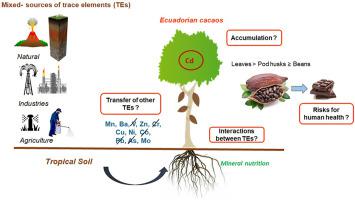Environmental Research ( IF 7.7 ) Pub Date : 2020-09-25 , DOI: 10.1016/j.envres.2020.110241 Fiorella Barraza , Eva Schreck , Gaëlle Uzu , Thibaut Lévêque , Cyril Zouiten , Mathieu Boidot , Laurence Maurice

|
Since cacao beans accumulate Cd in high levels and restrictions have been imposed on safe levels of chocolate consumption, concern about whether or not cacao trees store other toxic elements seems to be inevitable. Following a previous study in Ecuador examining Cd content in five cacao varieties collected in pristine areas and in places impacted by oil activities, we present here the concentrations of 11 trace elements (TEs) (As, Ba, Co, Cu, Cr, Mo, Mn, Ni, Pb, V and Zn) in soils, cacao tissues (leaves, pod husks, beans) and cocoa liquor (CL). Several TEs showed concentrations in topsoils above the Ecuadorian limits, and may have a mixed natural and anthropogenic origin. Ba and Mo concentrations in cacao tissues are slightly higher than those reported in other surveys, but this was not the case for toxic elements (As and Pb). TE contents are lower in CL, than in beans, except for Pb and Co, but no risk was identified for human health.
Compared with control areas, Enrichment Factors were below 2 in impacted areas, except for Ba. Transfer factors (from soils to cacao) indicated that cacao does not accumulate TEs. A positive correlation was found between Cd and Zn in topsoils and cacao tissues for the CCN-51 variety, and between Cd and Ni for the Nacional variety. Identifying patterns of TE distribution and potential interactions in order to explain plant internal mechanisms, which is also dependent on the cacao variety, is a difficult task and needs further research.
中文翻译:

镉积累以外:厄瓜多尔土壤和可可豆中其他微量元素的分布
由于可可豆中的Cd含量很高,并且限制了巧克力消费的安全水平,因此似乎不可避免地担心可可树是否会存储其他有毒元素。根据厄瓜多尔先前的一项研究,该研究调查了在原始地区和受石油活动影响的地方收集的五个可可树种中Cd的含量,在此我们介绍11种微量元素(TEs)的浓度(砷,钡,钴,铜,铬,土壤,可可组织(叶子,豆荚,豆类)和可可液(CL)中的Mn,Ni,Pb,V和Zn。几种TEs的表土土壤浓度超过了厄瓜多尔的界限,可能有自然和人为混合来源。可可组织中的Ba和Mo浓度略高于其他调查报告的浓度,但有毒元素(As和Pb)并非如此。
与控制区相比,除Ba外,受影响区的富集因子均低于2。转移因子(从土壤到可可粉)表明可可粉不积累TEs。对于CCN-51品种,在表土和可可组织中的Cd和Zn之间,以及对于Nacional品种,在Cd和Ni之间发现正相关。识别TE分布和潜在相互作用的模式以解释植物内部机制(也取决于可可树种)是一项艰巨的任务,需要进一步研究。











































 京公网安备 11010802027423号
京公网安备 11010802027423号